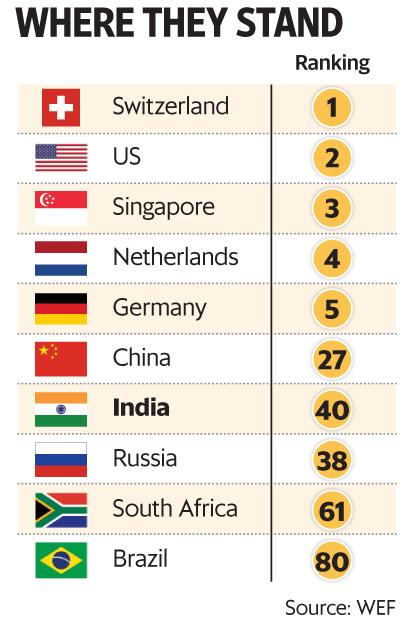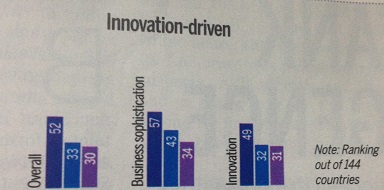Competitiveness and Indian business
This is a collection of articles archived for the excellence of their content. |
Contents |
Competitiveness Index, Global
2015
See seven graphics for 2015, and one for 2016.
2016: India jumps 16 places
India jumps 16 places in competitiveness index, Sep 28 2016 The Times of India
India jumped 16 places in the World Economic Forum's (WEF) 2016-17 Global Competitiveness Index (GCI) to emerge as the highest rising economy due to improvement in goods market efficiency, business sophistication and innovation.
India was ranked 39 out of 138 countries which were reviewed. This is the second year in a row that the country has climbed 16 places in the ranking, according to WEF.
Switzerland, Singapore and the US remain as the world's most competitive economies. China ranks 28 in the index. Among the other BRICS countries, Russia is ranked 43rd, South Africa at 47, while Brazil declined six notches to end up at 81.
“Thanks to improved monetary and fiscal policies, as well as lower oil prices, the Indian economy has stabilized and now boasts the highest growth among G20 economies,“ according to the GCI report. It measures 12 areas which include institutions, infrastructure, macroeconomic environment, health and primary education, higher education and training, goods and market efficiency , labour market efficiency among others. Economists said the go vernment's push to plug gaps in the economy had helped. “Relative to other economies, the Narendra Modi government has focussed on repair and reform of the economy which is pushing up India's competitiveness,“ said D K Joshi, chief economist at Crisil.“India's ranking in the World Bank's Ease of Doing Business is also likely to go up.“
2017: India drops 1 rank, to 40
Utpal Bhaskar, September 27, 2017: Livemint


India improves on WEF’s global competitiveness rankings
India is at Rank 40 in World Economic Forum’s (WEF) global competitiveness index, the highest in South Asia
India remains the most competitive country in South Asia, appearing at No. 40 in the global competitiveness ranking of 137 countries by the World Economic Forum (WEF). The ranking is one lower than last year’s, but the two rankings are not comparable because of a change in the methodology, WEF said.
WEF said India’s score is its highest ever according to the current methodology, which ranked Switzerland as the world’s most competitive economy. India’s competitiveness has improved, the report said. “Among the emerging markets seen as having great potential in the early 2000s, Brazil and Turkey have now lost much of the ground they gained before 2013, but China, India and Indonesia continue to improve.”
The findings come at a time when India is looking to scale 40 spots to reach the 90th rank in 2017-18 in the World Bank’s ease of doing business survey this year.
The report, however, cautioned against risks from uncertain global economic conditions. “Ten years on from the global financial crisis, the prospects for a sustained economic recovery remain at risk due to a widespread failure on the part of leaders and policymakers to put in place reforms necessary to underpin competitiveness,” WEF said in a statement.
The report remained upbeat about India, which is planning massive funding to bankroll its new infrastructure programme. “India (40th) stabilizes this year after its big leap forward of the previous two years. The score improves across most pillars of competitiveness, particularly infrastructure (66th, up by two), higher education and training (75th, up by six), and technological readiness (107th, up by three), reflecting recent public investments in these areas,” it said.
The WEF lauded India’s efforts in the information and communications technology (ICT) sector. “Performance also improves in ICT indicators, particularly Internet bandwidth per user, mobile phone and broadband subscriptions, and Internet access in schools,” the report added.
This in turn can provide a boost for the internet economy. While the total number of mobile internet users is expected to grow to almost 650 million by 2020, the number of users with high-speed internet access is expected to be around 550 million, according to The Boston Consulting Group. Data consumption is set to expand to around 7-10GB per month per user by 2020 from the current 700MB.
However, concerns remain on doing business. “The private sector still considers corruption to be the most problematic factor for doing business in India,” the report said.
“There is no doubt that there has been improvement in the business environment in India. However, much more needs to be done for the impact of policies to be felt on the ground,” said Sanjaya Baru, secretary general of the Federation of Indian Chambers of Commerce and Industry, a lobby group.
2018
October 24, 2018: The Times of India

India’s rank in the Global Competitiveness Index,
The extent to which senior management delegates authority
From: October 24, 2018: The Times of India
See graphic:
India and other major economies in 2018:
India’s rank in the Global Competitiveness Index,
The extent to which senior management delegates authority
Denmark may be the birthplace of the Lego tower, but its workplace hierarchy is the flattest in the world. According to the World Economic Forum’s Global Competitiveness Report 2018, the nation tops an index measuring “willingness to delegate authority” at work, beating 139 other countries. Denmark ranks 10th overall in the Global Competitiveness Index.
HERE, YOU CAN CRITICISE YOUR CEO TOO
Denmark, which has one of the smallest rich-poor gaps in the world, aims to offer ‘flexicurity’, or flexibility and security, to workers and companies. ‘Flexicurity’ provides less job protection but more social security. And the flat management hierarchy allows one to contradict or criticise managers.
2019: India slips 10 places
Oct 10, 2019: The Times of India

From: Oct 10, 2019: The Times of India
India slipped 10 places to the 68th rank in the World Economic Forum’s Global Competitiveness Index on account of a marginal decrease in its score and a significant improvement in case of others. In the global rankings, Singapore pipped the US to emerge at the top of the index, with Hong Kong moving up four places to be placed third. Among BRIC countries, only Brazil ranked lower than India, while Argentina was the other country among the G20 nations that is placed lower.
What was more worrisome is that on five parameters — ICT adoption, health, skills, product market and labour market — India ended up beyond the 100th place in the rankings that covered 141 countries. Only on four pillars it is among the top five countries — market size, innovation capability, financial system and macro-economic stability. Of the dozen factors on which countries are ranked, India had the highest score in market size, where it was ranked third.
The report noted that the country’s financial sector is relatively deep and stable, despite the high delinquency rate of 10% of the loan portfolio, which contributes to weakening of the soundness of its banking system.
“India performs well when it comes to innovation, well ahead of most emerging economies and on par with several advanced economies. This contrasts with major shortcomings in some of the basic enablers of competitiveness,” the report said.
In fact, India fared well on how fast the legal framework is adapting to digital business models such as ecommerce, sharing economy as well as fintech — ahead of countries such as Japan, Korea, Australia and France, according to the report.
But it pointed to gaps in the labour market. “As innovation capacity grows in emerging economies such as China, India and Brazil, they need to strengthen their skills and labour market to minimise risks of negative social spillovers. As innovation crosses borders, even countries with low innovation capability will need talent adaptability, making human capital investments one of the most critical factors of productivity in the coming decade,” the WEF report said.







